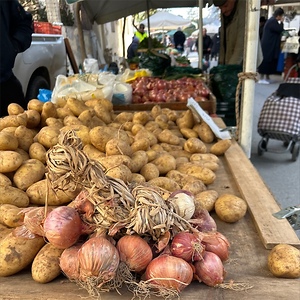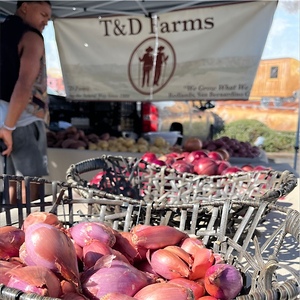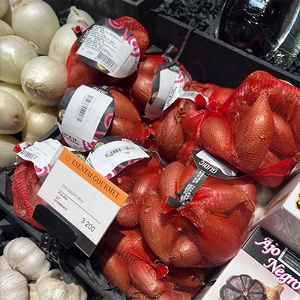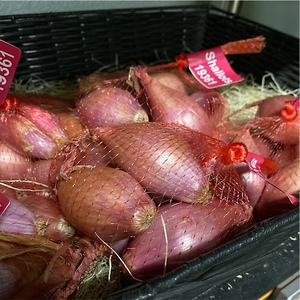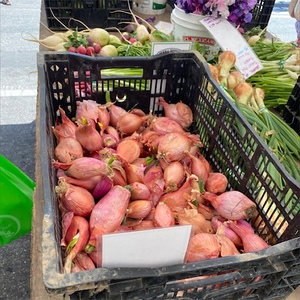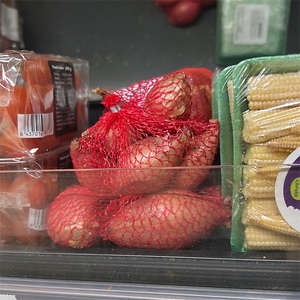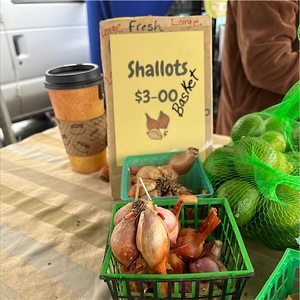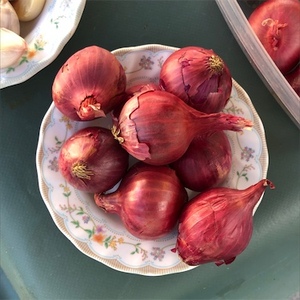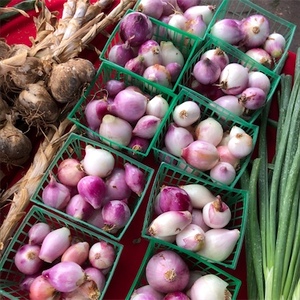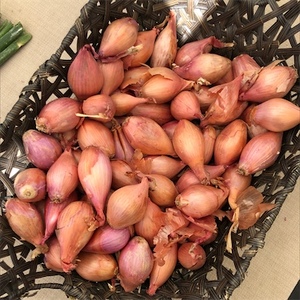


Shallots
Estimated Inventory, 5 lbs : 120.63
This item was last sold on : 07/24/25
Description/Taste
Shallots widely vary in size from small to large, depending on the variety, and have an elongated, oblong shape with a rounded center, tapering to a point at both ends. The bulbs are encased in a dry and papery, thin skin that flakes when touched and ranges in color from copper, gold, pale pink, to red. When the papery layers are removed, multiple clusters of cloves are found divided into individually wrapped segments similar to garlic. Small Shallot varieties average 2 to 3 cloves, and larger varieties typically contain 3 to 6 cloves. The firm, dense, and semi-dry flesh is off-white to translucent with light purple or red rings. Shallots are aromatic with a complex blend of spicy, sweet, and pungent flavors. When raw, the cloves are crisp and astringent, and when cooked, they develop a delicate, sweet, and savory taste with flavors reminiscent of garlic.
Seasons/Availability
Shallots are globally cultivated and available year-round.
Current Facts
Shallots, botanically classified Allium cepa, are multi-cloved bulbs belonging to the Amaryllidaceae family along with onions, garlic, and leeks. There are many different varieties of Shallots, and approximately thirteen varieties are commercially cultivated around the world in the modern-day. Within these varieties, there are two subgroups, Western Shallots and Eastern Shallots, that vary slightly in appearance and flavor. Shallots are an ancient crop that has been used for thousands of years in culinary and medicinal applications. The name Shallot was derived from Ascalon, which is an ancient city in Israel situated along the coast of the Mediterranean. Ascalon was the first city to introduce the pungent bulbs to Greece through trade, resulting in the Greeks referring to Shallots as the “Onion of Ascalon.” Over time through loose translations, the name Shallot was created and used to describe the variety. Shallots are highly favored by chefs for their aromatic, sweet, and complex, but not overpowering flavor and are used globally to flavor a wide variety of cuisines.
Nutritional Value
Shallots are an excellent source of fiber, stimulating the digestive system, and a good source of the minerals iron, potassium, and magnesium. The bulbs also contain vitamins A and C, which are antioxidants that can help strengthen the immune system, and provide some calcium, zinc, vitamin E, selenium, and phosphorus. In Asia, Shallots are used in traditional Ayurvedic medicine as an ingredient to internally heat the body to induce detoxification and are also believed to help increase immunity against sickness.
Applications
Shallots are best suited for both raw and cooked applications such as roasting, sautéing, and grilling. When raw, the bulbs can be chopped and mixed into salads, topped on bruschetta, blended into sauces such as Béarnaise, minced into guacamole, and stirred into vinaigrettes. Shallots can often be substituted in recipes calling for onions and garlic and have a slightly milder and sweeter flavor profile. In addition to raw preparations, Shallots can be sautéed with meats or cooked vegetables, stirred into lentil-based stews, blended into curries, baked into casseroles, stir-fried with rice, or tossed with pasta. They can also be roasted and dipped in a mixture of Greek yogurt and olive oil. Shallots pair well with beets, tomatoes, mushrooms, green beans, spinach, garlic, capers, meats such as poultry, beef, and pork, fish, baked oysters, cheeses such as parmesan, mozzarella, cheddar, and manchego, herbs such as parsley, thyme, rosemary, tarragon, and mint, and beer. The bulbs will keep up to one month when stored in a cool, dry, and dark place.
Ethnic/Cultural Info
Despite their strong association with French cuisine, traditionally used in roasts, stews, and sauces, Shallots are widely used throughout Asia for their milder pungency. In Southern India, Shallots are pickled in red vinegar and served as a condiment for curries, papads, which are flatbreads, sambar, and chora, which is a black-eyed pea stew. When pickled, Shallots develop a tangy, sour flavor that is believed to stimulate and enhance appetites when eaten at the beginning of a meal. Shallots are also known as Bawang Merah in Indonesia and are commonly used instead of regular onions in everyday cooking for their mild, less potent flavor. In Indonesia, the bulbs are pickled similarly to India for use as a condiment, or they are sliced, deep-fried, and served as a crunchy topping over soups, stews, rice, and curries.
Geography/History
Shallots are native to Asia and have been cultivated for over four thousand years. The specific region of origin within Asia is heavily debated among experts, with some linking the bulb to Southeast Asia while others to the city of Ascalon in Western Asia. In the 11th century, Shallots were rumored to have been introduced to Europe from crusaders returning from the middle east, and over time, the bulbs were spread throughout Western Europe through trade routes. Today Shallots are globally widespread and are available at farmer markets, specialty grocers, and supermarkets in North America, Central America, South America, Europe, Asia, Africa, and Australia.
Featured Restaurants
Restaurants currently purchasing this product as an ingredient for their menu.
| Fresh Sushi Catering | Carlsbad CA | 858-344-7098 |
| Coast Catering | Escondido CA | 619-295-3173 |
| Boujiemana | San Diego CA | 415-710-0510 |
| Chef Sebastian LLC | La Jolla CA | 858-740-0878 |
| Botanica | San Diego CA | 619-310-6320 |
| Giaola | Carlsbad CA | 858-266-9303 |
| Gravity Heights Mission Valley | San Diego CA | 619-384-5993 |
| Sensations Salud | San Diego CA | 619-933-3489 |
| Vagabond Sportfishing Inc. | San Diego CA | 619-993-9575 |
| Le Parfait Paris - Downtown | San Diego CA | 619-245-4457 |
| Siesel's Meats | San Diego CA | 619-275-1234 |
| Wildland | Carlsbad CA | 619-385-0914 |
| Gata | La Jolla CA | 858-336-5550 |
| Piatti | San Diego CA | 858-454-1589 |
| Patisserie Melanie | San Diego CA | 619-677-2132 |
| Coronado Yacht Club | Coronado CA | 619-435-1848 |
| The Shout House | San Diego CA | 619-231-6700 |
| Pretty Pickled, Pretty Sauced | National City CA | 619-869-9921 |
| Pali Wine Company | San Diego CA | 310-893-0038 |
| Stake Chophouse & Bar | Coronado CA | 619-522-0077 |
| US Grant Hotel Grill | San Diego CA | 619-232-3121 |
| Bound Coffee | Oceanside CA | 760-805-3505 |
| Salt & Whiskey | San Diego CA | 619-544-1886 |
| Comma | San Diego CA | 619-802-9183 |
| InterContinental Vistal Kitchen | San Diego CA | 619-501-9400 |
| Catania La Jolla | La Jolla CA | 619-884-5350 |
| Isola La Jolla | La Jolla CA | 858-412-5566 |
| Armonia LLC | San Diego CA | 619-724-7210 |
| Nomad Donuts | San Diego CA | 619-431-5000 |
| Olive Tree Marketplace | San Diego CA | 619-224-0443 |
| Chocolate Bar | Carlsbad CA | 442-500-2007 |
| Maderas Golf Club | Poway CA | 858-451-8100 |
| The Victorian at Hill Street | Oceanside CA | 442-266-8285 |
| Shoreside Support Boat | San Diego CA | 704-277-7929 |
| UCSD La Jolla (Pritikin Intensive) | San Diego CA | 858-657-6473 |
| Harvest Kitchen (Corp Lunch) | San Marcos CA | 619-709-0938 |
| Glenbrook Health Center | Carlsbad CA | 760-704-1000 |
| Green Acres Campus | San Diego CA | 858-450-9907 |
| Secret Sister | San Diego CA | 619-281-0718 |
| Marriott Courtyard - Broadway | San Diego CA | 619-446-3008 |
| Jeune Et Jolie | Carlsbad CA | 858-231-0862 |
| A & M catering | San Diego CA | 206-802-8320 |
| Rancho Valencia | Del Mar CA | 858-756-1123 |
| Special Order | San Diego CA | 619-876-4070 |
| Lucien | La Jolla CA | 707-387-7163 |
| Golden Door | San Marcos CA | 760-761-4142 |
| WaterBar | San Diego CA | 619-308-6500 |
| Leichtag Foundation | Encinitas CA | 760-230-6772 |
| Pacific Regent La Jolla | San Diego CA | 858-597-8008 |
| Matsu | Oceanside CA | 760-717-5899 |
| Kappa Sushi | San Diego CA | 858-566-3388 |
| The Crack Shack-Encinitas | Encinitas CA | 877-230-1871 |
| 31ThirtyOne by Deckman | San Diego CA | 619-495-9814 |
| The Corner Drafthouse | San Diego CA | 619-255-2631 |
| Bread & Cie Café | San Diego CA | 619-683-9322 |
| Choi's | San Diego CA | 858-900-1224 |
| Addison Del Mar | Del Mar CA | 858-350-7600 |
| The Whaling Bar | La Jolla CA | 858-355-9218 |
| Deeply Nourished | La Jolla CA | 808-489-7366 |
| University Club | San Diego CA | 619-234-5200 |
| Rancho Valencia New Restaurant | Del Mar CA | 858-756-1123 |
| Birdseye Rooftop | San Diego CA | 619-206-7220 |
| The Pearl Hotel | San Diego CA | 877-732-7573 |
| Mister A's | San Diego CA | 619-239-1377 |
| Ron Oliver | San Diego | 619-295-3172 |
| Merenda | Oceanside CA | 703-459-4145 |
| Cal A Vie | Vista CA | 760-945-2055 |
| Kettner Exchange | San Diego CA | 909-915-9877 |
| Small Barn | Temecula CA | 951-225-2822 |
| My Chef | San Diego CA | 916-217-0049 |
| Mission Pacific | Oceanside CA | 760-450-7864 |
| Lodge at Torrey Pines Main | San Diego CA | 858-453-4420 |
| Sago | Encinitas CA | 858-382-4047 |
| Parfait Paris (La Jolla) | La Jolla CA | 619-319-7811 |
| C 2 C | San Diego CA | 619-972-9345 |
| Something Homemade | Vista CA | 858-245-1004 |
| Michele Coulon Dessertier | San Diego CA | 858-456-5098 |
| Bar Same Same (Kitchen) | Carlsbad CA | 760-470-9143 |
| Pier 32 Water Front Grill | National City CA | 619-718-6240 |
| The Crack Shack PB | San Diego CA | 619-450-7978 |
| Kitchens for Good - Culinary Program | San Diego CA | 619-450-4040 |
| Toast Catering | San Diego CA | 619-795-9135 |
| Yoann Taboyan, Personal Chef | San Diego CA | 347-277-1958 |
| Relic Bageri LLC | San Diego CA | 619-335-6328 |
| Madison | San Diego CA | 619-822-3465 |
| Miho | San Diego CA | 619-365-5655 |
| Sonny's Pizza | San Diego CA | 619-432-1838 |
| Chef Jenn | Solana Beach CA | 858-212-9054 |
| Sandpiper Wood Fired Grill & Oysters | La Jolla CA | 858-228-5655 |
| The Original 40 Brewing | San Diego CA | 619-206-4725 |
| Toast Cafe | San Diego CA | 858-208-9422 |
| Sets Kitchen and Bar | San Marcos CA | 970-390-2148 |
| Farmer and The Seahorse | San Diego CA | 619-302-3682 |
| Sugar Bear Enterprises | San Diego CA | 925-383-3623 |
| Paradisaea Restaurant | La Jolla CA | 732-915-6669 |
| The Besta-Wan Pizza House | Cardiff CA | 805-231-2515 |
| Mille Fleurs | Rancho Santa Fe CA | 858-756-3085 |
| Barra Oliba | San Diego CA | 610-310-5110 |
| WineSellar & Brasserie | San Diego CA | 858-450-9557 |
| Sovereign Thai Cuisine | San Diego CA | 619-887-2000 |
| Gravity Heights Restaurant and Brewery | San Diego CA | 858-551-5105 |
| The Crack Shack-San Diego | San Diego CA | 619-795-3299 |
| Il Giardino di Lilli | La Jolla CA | 619-467-9897 |
| The Butchery | San Diego CA | 858-345-1524 |
| Slowly | San Diego CA | 858-352-6080 |
| Crafted @ Minerva's Cafe | La Jolla CA | 858-699-4129 |
| Justin Hoehn | San Diego CA | 619 326 8895 |
| Happy Medium SD | San Diego CA | 509-869-2279 |
| The Crack Shack Costa Mesa | Costa Mesa CA | 951-808-7790 |
| Portside Pier (Ketch Tasting Deck) | San Diego CA | 858-268-1030 |
| Park Commons - ARE | San Diego CA | 619-295-3172 |
| Pamplemousse Grill | Solana Beach CA | 858-792-9090 |
| Bica | San Diego CA | 619-669-5725 |
| 619 Spirits | San Diego CA | 509-701-9534 |
| Little Lion | San Diego CA | 619-519-4079 |
| Grass Skirt | San Diego CA | 858-412-5237 |
| Blue Water Estate Services | Rancho Santa Fe CA | 858-720-9831 |
| Blue Ocean Sushi & Grill (UTC) | San Diego CA | 858-886-9909 |
| Jalisco Cantina | Carlsbad CA | 619-204-5945 |
| Salt and Lime | Del Mar CA | 858-926-8582 |
| Institutes of Health LLC | San Diego CA | 800-270-5016 |
| Moniker Coffee Company (Bar Food) | San Diego CA | 916-945-6721 |
| Fishery | San Diego CA | 858-272-9985 |
| The Bower | Coronado CA | 949-212-3192 |
| Webbcreationfood LLC | San Diego CA | 619-829-9194 |
| The Guild Hotel | San Diego CA | 619-764-5108 |
| The Haven (Pizzeria) | San Diego CA | 619-964-3778 |
| Flora Cafe | Bonita CA | 619-339-6604 |
| Fresco Cocina | Carlsbad CA | 760-720-3737 |
| Black Radish | San Diego CA | 619-775-7412 |
Recipe Ideas
Recipes that include Shallots. One



